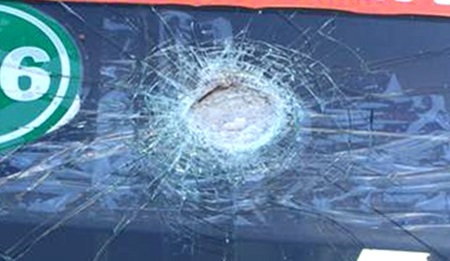
Cameras will be installed along the HCM City-Long Thanh-Dau Giay Expressway to prevent stone–pelting that damaged several cars travelling on the route, the Vietnam Expressway Corporation has said.
Cameras will be installed along the HCM City-Long Thanh-Dau Giay Expressway to prevent stone–pelting that damaged several cars travelling on the route, the Vietnam Expressway Corporation has said.
 |
| A passenger bus was pelted with stones when it was travelling along the Long Thanh-Dau Giay Expressway. — Photo of the management board of the Long Thanh-Dau Giay Expressway |
Nguyen Thi Hoai Phuong, of the Vietnam Expressway Services Engineering JSC, which is also the management board of the expressway, said the firm has installed fences at overpasses along the route and mobilised patrol teams to curb stone-pelting.
Phuong said eight buses were reportedly pelted with stones within a year of the route opening to traffic, causing some damage to the vehicles and affecting people's safety along the route.
Last month, a car was pelted by stones when it was passing the Long Thanh Bridge near the Long Phuoc Toll Station. The car's windshield broke and the culprit managed to flee.
Last September, a passenger bus was attacked and its window broke. Fortunately, no one was injured. Stone attacks were reported earlier too.
Most of the drivers said they were frightened of losing control and causing accidents as cars drive at high speed on the route.
The police in Dong Nai Province are hunting for the culprits. Police have also stepped up surveillance and patrols along the route to detect similar cases.
The 55-km HCM City-Long Thanh-Dau Giay Expressway, with an initial construction cost of VND20.63 trillion (US$970 million), was put into operation last February.
The highway has a maximum vehicle speed of 80-120 km per hour, with eight lanes. It was funded by the Asia Development Bank, the Japan International Cooperation Agency's official development assistance, and the Vietnamese government.
The highway has helped ease traffic congestion, reduce transport cost and time and promote trade between HCM City and its vicinities.
(Source:VNS)




